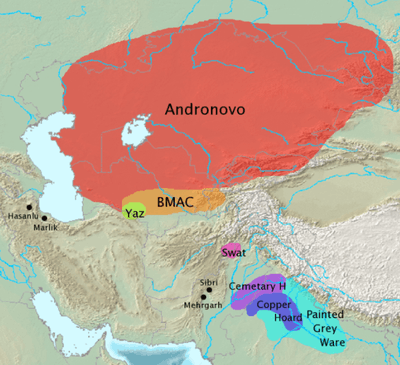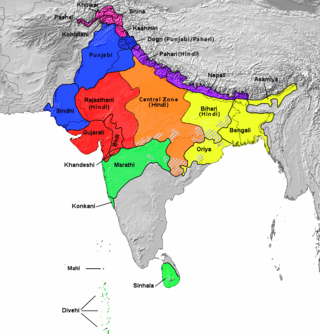Indo-Aryan peoples
|
Geographical distribution of the major Indo-Aryan languages. | |
| Total population | |
|---|---|
| approximately 1.21 billion | |
| Regions with significant populations | |
| over 856 million[1] | |
| over 164 million[2] | |
| over 171 million[3] | |
| over 26 million | |
| over 14 million | |
| over 1 million | |
| over 300,000 | |
| Languages | |
| Indo-Aryan languages | |
| Religion | |
| Indian religions (Mostly Hindu; with Buddhist, Sikh and Jain minorities) and Islam, some non-religious atheist/agnostic and Christians | |
| Part of a series on |
| Indo-European topics |
|---|
|
|
Origins |
|
Archaeology Pontic Steppe East-Asia Eastern Europe Northern Europe Pontic Steppe Northern/Eastern Steppe Europe South-Asia Steppe Europe Caucasus India |
|
Peoples and societies Indo-Aryans Iranians Europe East-Asia Europe Indo-Aryan Iranian |
|
Religion and mythology
Indian Iranian Other Europe |
Indo-Aryan peoples are a diverse Indo-European ethnolinguistic group of peoples who speak Indo-Aryan languages. The Indo-Aryan languages belong to the Indo-Iranian branch of the Indo-European language family. Today, there are over one billion native speakers of Indo-Aryan languages, most of them native to South Asia, where they form the majority.[note 1]
History
The Indo-European languages were introduced into northern India by Indo-Aryans. The Indo-Aryan migration theory[note 2] explains the introduction of the Indo-Aryan languages in the Indian subcontinent by proposing a migration from the Sintashta culture[5][6] through the Bactria-Margiana Culture and into the northern Indian subcontinent (modern day India, Nepal, Bangladesh and Pakistan). These migrations started approximately 1,800 BCE, after the invention of the war chariot, and also brought Indo-Aryan languages into the Levant and possibly Inner Asia. It was part of the diffusion of Indo-European languages from the proto-Indo-European homeland at the Pontic steppe, a large area of grasslands in far Eastern Europe, which started in the 5th to 4th millennia BCE, and the Indo-European migrations out of the Eurasian steppes, which started approximately 2,000 BCE.
The theory posits that these Indo-Aryan speaking people may have been a genetically diverse group of people who were united by shared cultural norms and language, referred to as aryā, "noble." Diffusion of this culture and language took place by patron-client systems, which allowed for the absorption and acculturalisation of other groups into this culture, and explains the strong influence on other cultures with which it interacted.The Proto-Indo-Iranians, from which the Indo-Aryans developed, are identified with the Sintashta culture (2100–1800 BCE),[7] and the Andronovo culture,[8] which flourished ca. 1800–1400 BCE in the steppes around the Aral sea, present-day Kazakhstan, Uzbekistan and Turkmenistan. The proto-Indo-Iranians were influenced by the Bactria-Margiana Culture, south of the Andronovo culture, from which they borrowed their distinctive religious beliefs and practices. The Indo-Aryans split off around 1800-1600 BCE from the Iranians,[9] whereafter the Indo-Aryans migrated into the Levant and north-western India.[10]
List of Indo-Aryan peoples
Historical

Contemporary
- Assamese people
- Awadhi people
- Bengali people
- Bhil people
- Bihari people
- Chhettris
- Chittagonians
- Dogras
- Dom people
- Garhwalis
- Gujarati people
- Gurkhas
- Hindkis
- Hindkowans
- Kambojs
- Kamein
- Khas people
- Khatris
- Koli people
- Konkani people
- Kumaoni people
- Lhotshampas
- Lohanas
- Dhivehi people
- Marathi people
- Marwaris
- Mers people
- Muhajirs
- Naga Rajputs
- Nais
- Newar people
- Oriya people
- Punjabi people
- Rajputs
- Ramgarhia
- Romani people
- Rohingya people
- Saraiki people
- Saraswats
- Sinhalese people
- Sindhi people
- Sylheti people
- Jats
See also
Notes
- ↑ Note the difference between linguistic and genetic distinction of South Asians. According to Reich et. al (2009), while the Indo-Aryan linguistic group occupies mainly northern parts of India, genetically, all South Asians across the subcontinent are a mix of both Indo-Aryan and Dravidian gene groups. Recent studies have indicated a distinct Ancestral North Indian (ANI) population and Ancestral South Indian (ASI) population which mixed over thousands of years to produce the current South Asian population. Northern Indians and traditionally upper castes (such as Kashmiri Pandits and Telugu Brahmins) are more related to Western Eurasians while Southern Indians and lower castes are less related to Western Eurasians.
- ↑ The term "invasion" is only being used nowadays by opponents of the Indo-Aryan Migration theory.[4] The term "invasion" does not reflect the contemporary scholarly understanding of the Indo-Aryan migrations,[4] and is merely being used in a polemical and distractive way.
References
- ↑ "India". The World Factbook.
- ↑ "Pakistan". The World Factbook.
- ↑ "Bangladesh". The World Factbook.
- 1 2 Witzel 2005, p. 348.
- ↑ Anthony 2007, pp. 408–411.
- ↑ Kuz'mina 2007, p. 222.
- ↑ Anthony 2007, p. 390 (fig. 15.9), 405-411.
- ↑ Anthony 2009, p. 49.
- ↑ Anthony 2007, p. 408.
- ↑ George Erdosy(1995) "The Indo-Aryans of Ancient South Asia: Language, Material Culture and Ethnicity.", p.279
Sources
- Anthony, David W. (2007). The Horse The Wheel And Language. How Bronze-Age Riders From the Eurasian Steppes Shaped The Modern World. Princeton University Press.
- Beckwith, Christopher I. (16 March 2009). Empires of the Silk Road: A History of Central Eurasia from the Bronze Age to the Present. Princeton University Press. ISBN 1400829941. Retrieved 30 December 2014.
- Bryant, Edwin (2001). The Quest for the Origins of Vedic Culture. Oxford University Press. ISBN 0-19-513777-9.
- Loewe, Michael; Shaughnessy, Edward L. (1999). The Cambridge History of Ancient China: From the Origins of Civilization to 221 BC. Cambridge University Press. pp. 87–88. ISBN 0-5214-7030-7. Retrieved November 1, 2013.
- Mallory, JP. 1998. "A European Perspective on Indo-Europeans in Asia". In The Bronze Age and Early Iron Age Peoples of Eastern and Central Asia. Ed. Mair. Washington DC: Institute for the Study of Man.
- Trubachov, Oleg N., 1999: Indoarica, Nauka, Moscow.
- Witzel, Michael (2005), "Indocentrism", in Bryant, Edwin; Patton, Laurie L., The Indo-Aryan Controversy. Evidence and inference in Indian history (PDF), Routledge
